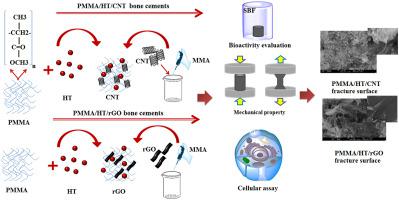Journal of the Mechanical Behavior of Biomedical Materials ( IF 3.3 ) Pub Date : 2021-01-21 , DOI: 10.1016/j.jmbbm.2021.104320 F. Pahlevanzadeh , H.R. Bakhsheshi-Rad , M. Kharaziha , M. Kasiri-Asgarani , M. Omidi , M. Razzaghi , Ahmad Fauzi Ismail , Safian Sharif , Seeram RamaKrishna , F. Berto

|
Polymethyl methacrylate (PMMA) bone cements (BCs) have some drawbacks, including limited bioactivity and bone formation, as well as inferior mechanical properties, which may result in failure of the BC. To deal with the mentioned issues, novel bioactive polymethyl methacrylate-hardystonite (PMMA-HT) bone cement (BC) reinforced with 0.25 and 0.5 wt% of carbon nanotube (CNT) and reduced graphene oxide (rGO) was synthesized. In this context, the obtained bone cements were evaluated in terms of their mechanical and biological characteristics. The rGO reinforced bone cement exhibited better mechanical properties to the extent that the addition of 0.5 wt% of rGO where its compressive and tensile strength of bioactive PMMA-HT/rGO cement escalated from 92.07 ± 0.72 MPa, and 40.02 ± 0.71 MPa to 187.48 ± 5.79 MPa and 64.92 ± 0.75 MPa, respectively. Besides, the mechanisms of toughening, apatite formation, and cell interaction in CNT and rGO encapsulated PMMA have been studied. Results showed that the existence of CNT and rGO in BCs led to increase of MG63 osteoblast viability, and proliferation. However, rGO reinforced bone cement was more successful in supporting MG63 cell attachment compared to the CNT counterpart due to its wrinkled surface, which made a suitable substrate for cell adhesion. Based on the results, PMMA-HT/rGO can be a proper bone cement for the fixation of load-bearing implants.
中文翻译:

CNT和rGO增强的PMMA基骨水泥,用于固定负重植入物:力学性能和生物学响应
聚甲基丙烯酸甲酯(PMMA)骨水泥(BCs)具有一些缺点,包括有限的生物活性和骨形成以及较差的机械性能,可能导致BC失效。为了解决上述问题,合成了新型的生物活性的聚甲基丙烯酸甲酯-硬硅钙石(PMMA-HT)骨水泥(BC),该骨水泥用0.25和0.5 wt%的碳纳米管(CNT)和还原的氧化石墨烯(rGO)增强。在这种情况下,对获得的骨水泥的力学和生物学特性进行了评估。rGO增强的骨水泥表现出更好的机械性能,其程度为:添加0.5 wt%的rGO,其生物活性PMMA-HT / rGO水泥的抗压强度和拉伸强度从92.07±0.72 MPa和40.02±0.71 MPa升高至187.48±分别为5.79 MPa和64.92±0.75 MPa。除了,研究了碳纳米管和rGO封装的PMMA中增韧,磷灰石形成和细胞相互作用的机理。结果显示,BCs中CNT和rGO的存在导致MG63成骨细胞的活力增加和增殖。然而,与碳纳米管相比,rGO增强的骨水泥比CNT更为成功地支持了MG63细胞的附着,这是因为它的表面起皱,这使它成为细胞粘附的合适基质。根据结果,PMMA-HT / rGO可以作为固定负重植入物的合适骨水泥。与CNT对应物相比,rGO增强骨水泥在支持MG63细胞附着方面更为成功,因为其表面起皱,这使它成为细胞粘附的合适基质。根据结果,PMMA-HT / rGO可以作为固定负重植入物的合适骨水泥。与CNT对应物相比,rGO增强骨水泥在支持MG63细胞附着方面更为成功,因为其表面起皱,这使它成为细胞粘附的合适基质。根据结果,PMMA-HT / rGO可以作为固定负重植入物的合适骨水泥。











































 京公网安备 11010802027423号
京公网安备 11010802027423号